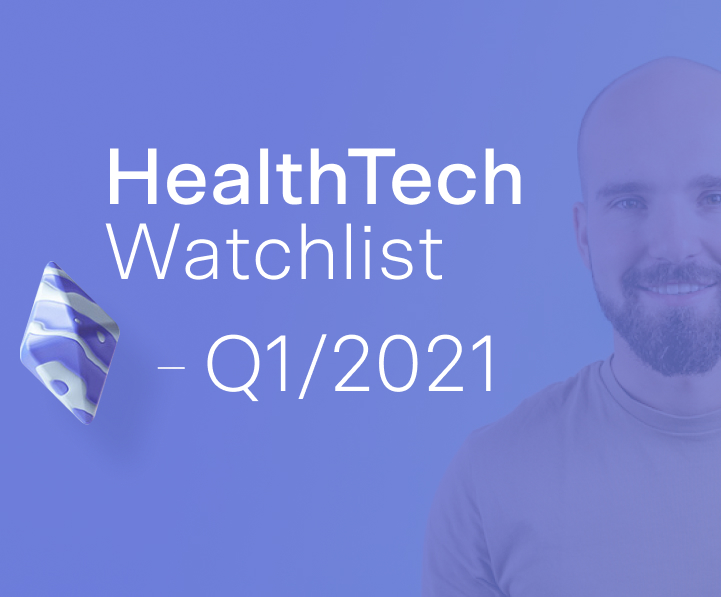February 21, 2021
DevelopmentCommunity
A watchlist of interesting HealthTech startups Q1/2021
5 min reading

2020 was an exceptional year for the healthtech industry, considering the dramatic pressure that COVID-19 put on the sector, across the NHS and other social organizations all over the world.
Although European fintech startups are leading the race when it comes to investments during 2020, in this article we will focus on the Health Tech sector as it’s expected to see the largest increase in investment in 2021.
Let’s explore a couple of facts:
- The healthcare sector saw the biggest increase in investments from 2019 to 2020 – $750m.
- More than 90% of investors expect mental health startup returns to be in line with, or better than, returns on startup investments in other sectors.
- This year, opportunities lie in the virtualisation of the healthcare environment to provide similar or even better patient support than the real world
- With the rise in remote patient monitoring and the use of IoMT (Internet of Medical Things), healthcare organisations can access and analyse larger pools of anonymised patient data and real world evidence
Venture investors often tend to chase untested concepts or innovations without proper investigation or evidence-based research on the impact of their value. In the case of the healthtech industry, it's a totally different situation.
It’s great to observe how physical and mental health start to matter on a larger scale for investors and society, and global healthcare spending is estimated to reach over $10 trillion USD by 2022. Digitization will hopefully lead to quality patient care and promote personalized healthcare services - from our side, we are glad to be playing a part by developing our mental health company VOS.health and by helping our clients in healthtech grow and develop their services.
6 WatchList startups for the beginning of 2021
1) Nanome
The Future of Molecular Design
Nanome.ai is San-Francisco-based startup, which raised $3 million last year to help scientists get up close with molecular structures in VR. The tool is a global, real-time collaboration system, using Virtual Reality in everything from general chemistry to pharmaceutical drug discovery.
Discovery and research of new molecular compounds is an expensive business. The development costs exceed $10 billion per substance in some cases. With the COVID-19 pandemic limiting access to in-lab tools, Nanome’s VR project has become more relevant than ever.
Check out more at: https://nanome.ai
2) Everlywell
Demand better for your body
Everlywell can provide at-home lab testing to a variety of populations. The startup has raised $75 million, following the close of the $175 million Series D.
The company already works with employers and health plans, but this should definitely help accelerate its business as it looks toward more growth in 2021 and beyond.
3) Varjo
XR/VR headsets to take medicine to a higher level
Varjo is Finnish startup which raised €45.9m last year. Varjo XR/VR headsets take you to another level of performance and emotional immersion – recreating the exact feeling and conditions of real life, allowing you to perform better and learn faster.
With its headset it can take medical professionals to a higher level of focus and emotional engagement. Medical personnel can also prepare and practice for the most challenging scenarios they may come upon.
Check more at: https://varjo.com/solutions/medical/
4) LiveHealthily
The self-care app. Helping you look after you.
LiveHealthily is a “self-care” platform that brings medical knowledge out of the clinic and into everyday life. The tool uses artificial intelligence to help users check their symptoms before deciding to see a doctor.
Check out more here: https://www.livehealthily.com
5) Pace Group
Share your feelings with people who listen.
The COVID-19 pandemic has had significant psychological and social effects on the world population. Pace, a new startup founded by Pinterest and Affirm executives, has launched with $1.9 million in seed funding to help people connect online and maintain their mental health through digital rooms.
How does it work? Pace helps people to form asnd run small groups (8-10) people on a weekly basis. Usually, the group is led by amazing and experienced facilitators - Pace doesn’t follow any specific curriculum during the meetings, but instead uses the time for people to talk through their feelings.
Check out more here: https://pace.group
6) AgeBold
Senior-focused wellness program.
Virtual health and wellness programs have grown increasingly popular throughout the pandemic. Bold is a senior-focused fitness startup, which recently raised $7M in 2020.
The company's range of services includes energizing fitness classes featuring expert trainers and personalized programs that improve strength, balance, vibrancy and mobility, enabling older adults and other individuals to foster healthy aging and independence.
Currently the leading cause of injury among older adults is falling. Therefore, even simple, low-intensity exercise can improve balance and strength, enough to reduce risks and improve wellbeing.
Explore more at: https://www.agebold.com